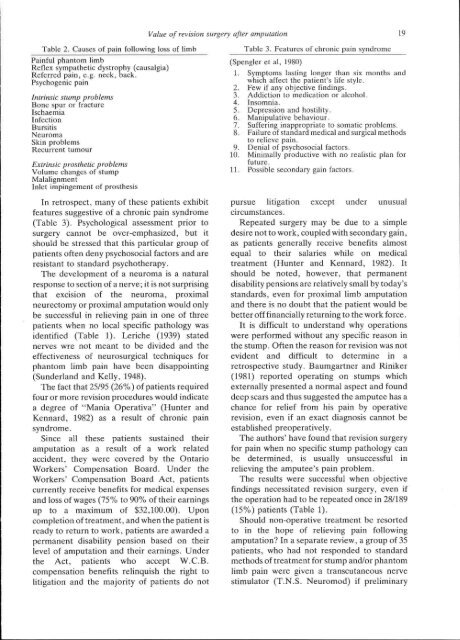View Complete Issue PDF
View Complete Issue PDF
View Complete Issue PDF
You also want an ePaper? Increase the reach of your titles
YUMPU automatically turns print PDFs into web optimized ePapers that Google loves.
Table 2. Causes of pain following loss of limb<br />
Table 3. Features of chronic pain syndrome<br />
In retrospect, many of these patients exhibit<br />
features suggestive of a chronic pain syndrome<br />
(Table 3). Psychological assessment prior to<br />
surgery cannot be over-emphasized, but it<br />
should be stressed that this particular group of<br />
patients often deny psychosocial factors and are<br />
resistant to standard psychotherapy.<br />
The development of a neuroma is a natural<br />
response to section of a nerve; it is not surprising<br />
that excision of the neuroma, proximal<br />
neurectomy or proximal amputation would only<br />
be successful in relieving pain in one of three<br />
patients when no local specific pathology was<br />
identified (Table 1). Leriche (1939) stated<br />
nerves wre not meant to be divided and the<br />
effectiveness of neurosurgical techniques for<br />
phantom limb pain have been disappointing<br />
(Sunderland and Kelly, 1948).<br />
The fact that 25/95 (26%) of patients required<br />
four or more revision procedures would indicate<br />
a degree of "Mania Operativa" (Hunter and<br />
Kennard, 1982) as a result of chronic pain<br />
syndrome.<br />
Since all these patients sustained their<br />
amputation as a result of a work related<br />
accident, they were covered by the Ontario<br />
Workers' Compensation Board. Under the<br />
Workers' Compensation Board Act, patients<br />
currently receive benefits for medical expenses<br />
and loss of wages (75% to 90% of their earnings<br />
up to a maximum of $32,100.00). Upon<br />
completion of treatment, and when the patient is<br />
ready to return to work, patients are awarded a<br />
permanent disability pension based on their<br />
level of amputation and their earnings. Under<br />
the Act, patients who accept W.C.B,<br />
compensation benefits relinquish the right to<br />
litigation and the majority of patients do not<br />
pursue litigation except under unusual<br />
circumstances.<br />
Repeated surgery may be due to a simple<br />
desire not to work, coupled with secondary gain,<br />
as patients generally receive benefits almost<br />
equal to their salaries while on medical<br />
treatment (Hunter and Kennard, 1982). It<br />
should be noted, however, that permanent<br />
disability pensions are relatively small by today's<br />
standards, even for proximal limb amputation<br />
and there is no doubt that the patient would be<br />
better off financially returning to the work force.<br />
It is difficult to understand why operations<br />
were performed without any specific reason in<br />
the stump. Often the reason for revision was not<br />
evident and difficult to determine in a<br />
retrospective study. Baumgartner and Riniker<br />
(1981) reported operating on stumps which<br />
externally presented a normal aspect and found<br />
deep scars and thus suggested the amputee has a<br />
chance for relief from his pain by operative<br />
revision, even if an exact diagnosis cannot be<br />
established preoperatively.<br />
The authors' have found that revision surgery<br />
for pain when no specific stump pathology can<br />
be determined, is usually unsuccessful in<br />
relieving the amputee's pain problem.<br />
The results were successful when objective<br />
findings necessitated revision surgery, even if<br />
the operation had to be repeated once in 28/189<br />
(15%) patients (Table 1).<br />
Should non-operative treatment be resorted<br />
to in the hope of relieving pain following<br />
amputation? In a separate review, a group of 35<br />
patients, who had not responded to standard<br />
methods of treatment for stump and/or phantom<br />
limb pain were given a transcutaneous nerve<br />
stimulator (T.N.S. Neuromod) if preliminary
















